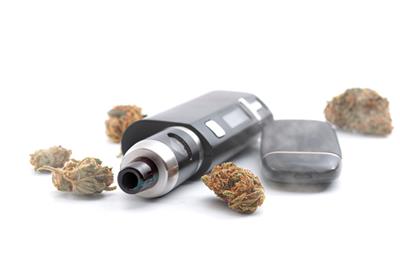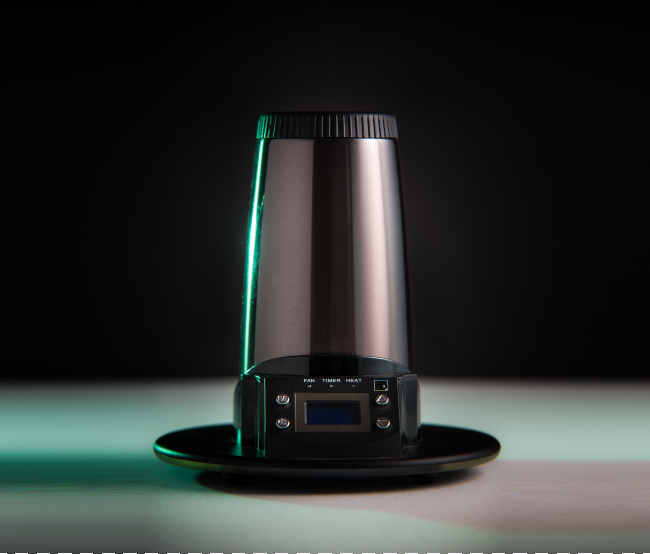
Friday December 31, 2021
By Erin Hiatt
 420 Culture
420 Culture
Vaporizing cannabis, in its simplest iteration, as described by Medical Jane, “is the process of heating dried cannabis to a temperature just below its combustion point of 392 degrees Fahrenheit.”
When marijuana is vaporized, especially at the appropriate temperature, it has the benefit of releasing the plant’s cannabinoids and terpenes without the combustion (burning) that happens when lighting a joint, bowl, or bong.
Vaporization is favored by many because combustion introduces a number of unwanted, potentially harmful substances into your smoke (such as benzine), and is less efficient at delivering cannabinoids (meaning vaporization is more potent). Not only that, but combustion is also incredibly hot — a lit joint can give off an inhale of 1000 degrees Fahrenheit, as well as cause potential respiratory problems and release harmful chemicals correlated with carcinogens.
The vape market (including e-cigs and cannabis vaporizers) has exploded in the past few years, and is projected to reach $47.11 billion by 2025. The market comprises three different vaporizers types; pen vaporizers, portable vaporizers, and stationary vaporizers. And though they vary in shape and size, they are composed of a heating source and delivery system.
Pen Vaporizers
Pen vaporizers, popularly known as vape pens, are named for what they most closely and obviously resemble, a pen. Vape pens are incredibly popular because they are discrete, easy to use — especially for those new to cannabis — and emit much less odor than a joint or other consumption method.
Vape pens are designed for cannabis oil that is generally preloaded in replaceable cartridges. Another reason that vape pens are so popular is due to their potency. Typically, they are more potent than consuming flower because they are extracted concentrates. Others prefer oils because you can use less product to achieve the same effect as say, smoking a joint.
Vape pens are so popular that they are the main driver of concentrate sales. BDS Analytics is a cannabis firm that reports market trends, analyses, and cannabis consumer research, and according to Linda Gilbert, analytics manager director of consumer insights at BDS, 58 percent of concentrate spending in 2018 was from prefilled vaporizers.
Vape pens most frequently use conduction heating, where the product comes in direct contact with an electrically heated surface, usually through a solid metal or screen. One thing to keep in mind with a conduction heating method is that it distributes heat poorly, making it harder to regulate the temperature precisely.
Portable Vaporizers
Very similar to vape pens, though slightly larger, are portable vaporizers. Most portable vapes, such as a Pax or Flowermate, are rechargeable and often come with features like Bluetooth, different temperature settings, and even apps affiliated with the vaporizer.
Consuming dry herb is a snap with a portable vape, and it makes for a convenient way to save your ABV, or “already been vaped” bud. Typically, after a vape session, people throw out the used product.
Instead of tossing it out, ABV can be used to sprinkle on food, made into edibles, or even packed in gelatin capsules. The bonus here is that ABV has already been through the process of decarboxylation, the heating process that turns the raw cannabis compound THCA — which will not get you high — into THC, which will.
Most portable vapes also utilize conduction heating, but others use convection heating, where heated air passes over the dry herb, heating bud more evenly. Since the cannabis does not actually touch the heating element, typically made out of ceramic or stainless steel, it is often preferred by medical patients and others looking for a method that will best deliver the most intact cannabinoid compounds.
Tabletop Vapes (Whip and Bag)
With a whip system, cannabis is heated via convection, then a fan or pump forces the air to the mouthpiece through approximately three feet of silicone tubing, with one end attached to the mouthpiece, the other attached to a glass chamber that holds the cannabis and the heating element. A bag vape has a heating unit, a bag (aka balloon) that holds the vapor made from food grade plastic
that can attach and detach from the heating unit and a mouthpiece. A bag vape is more portable than a whip system, because the bag can be removed from the heating unit.
Whip and bag vape systems are not as convenient as vape pens and portable vapes, they take up space and are intended for in-home use. However, it is much easier to change the vaporization temperature, use different fan speeds, and even change the draw pull for a more personalized experience.
Some of these systems, like the Arizer Extreme Q, are designed to accommodate both whip and bag systems.
Conclusion
What kind of vape experience you choose will depend a lot on how clean and efficient you want your delivery method to be, what kind of conveniences you’re looking for, as well as how much money you want to spend. Vape pens cost anywhere between $10-$50, but this system seems to be the least desirable based on efficacy. Portable vapes cost a bit more, but have more and cleaner heating options. For medical patients, where cannabinoid delivery and medicinal efficacy is key, a stationary vape system, though the most expensive, costing anywhere from $150-$500, would be a sound investment.
Frequently Asked Questions
Are Vaporizers for Concentrates or Flower?
Vaporizers can be for either concentrate, flower, or both depending on the design. Typically, the vaporizer will need some sort of attachment to switch between types, or will be designed specifically for one or the other. Overall, there are vaporizers available for both options, but not every vaporizer can do both.
Do Vaporizers Burn Weed?
Ideally, no. When set to the proper temperature, a vaporizer should not combust the bud. As temperature increases, you’ll get a more “toasted” result, which may not fully combust, but will still heat cannabinoids past their optimal temperatures and start to degrade them.
What’s your preferred way to vape? Puff and pontificate in the comments.
Photo Credit: Victor Moussa (license)










